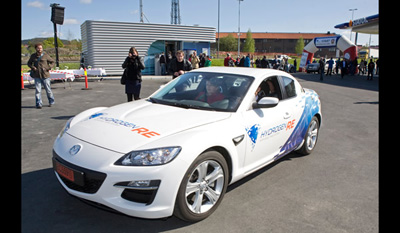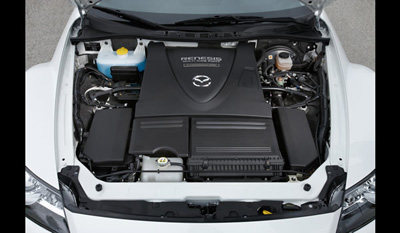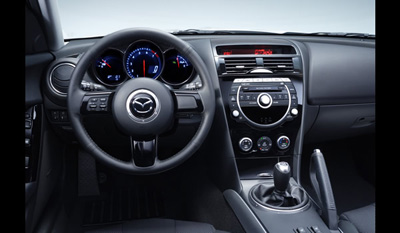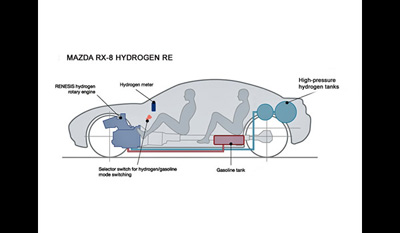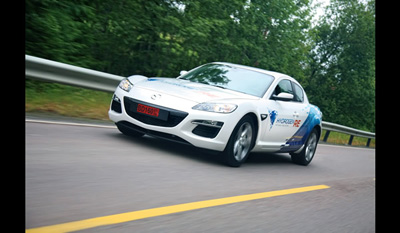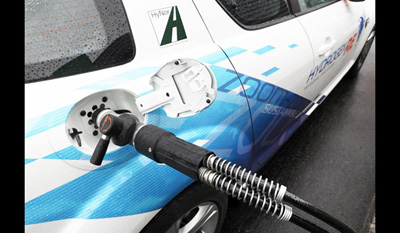MAZDA RX-8 Hydrogen Rotary Engine 2003 2009
Mazda's interest in hydrogen vehicles covers a span of 15 years; the first prototype, the Mazda HR-X Concept, was presented at the 1991 Tokyo Motor Show. For further details, see Car Reviews, Mazda HRX Concept 1991. Even back then, the concept car had a hydrogen powered rotary piston engine as its powerplant. The hydrogen powered Mazda prototypes resulting from this intense research work have succeeded one another up to the latest Mazda RX-8 Hydrogen RE concept car presented at the 2003 Tokyo Motor Show. The 2004 road homologated prototype formed the basis of the Mazda RX-8 Hydrogen RE which is actually driven on public roads in Japan. Equipped with a dual fuel power system, it is capable of operating just as well on hydrogen as on gasoline, making it easier to use in everyday life. In 2006 the Mazda RX-8 Hydrogen Re vehicle are supplied on a lease base to Japanese companies and local governments. This unique "commercial" endeavour is providing Mazda with valuable experience for the future development of its hydrogen powered vehicles. More recently, Mazda entered the HyNor Project in Norway. The HyNor Project is creating the first infrastructure for hydrogen fuel transportation system in Norway between Oslo and Stavanger with several hydrogen filling stations using different supply systems from methane reforming, trucked hydrogen, hydrogen from chlorine production, hydrogen from biomass or hydrogen from electrolysis based on renewable energy. The HyNor Project was created to promote hydrogen as an alternative fuel in Norway. Akihiro Kashiwagi, Hydrogen RE Program Manager explains: " A hydrogen rotary engine only emits water. It is not as efficient as a fuel cell, but structurally it is closer to the gasoline engine, hence its manufacturing cost is lower and it has fewer durability issues. Compared to fuel cells, Hydrogen engines with dual fuel system are more likely to play a significant role in the initial phase of the hydrogen energy society of the future. That is why Mazda is currently focused on developing dual fuel system hydrogen engine. Furthermore, under normal circumstances, a hydrogen vehicle is fueled by hydrogen gas for clean driving. But what if a hydrogen vehicle is also powered by gasoline? It would mean greater convenience, because the driver does not have to worry about running out of hydrogen gas or about driving to a place where there are no hydrogen filling stations. Mazda has achieved such a system and calls it "dual-fuel system", a highly innovative function not achieved with fuel cell vehicles."
The Mazda RX-8 Hydrogen RE has a range of 100 km under hydrogen and 550 km under gasoline due to 110 litres high pressure (350 bar or 35 MPa) tanks and conventional 61 litres gasoline tank. The Rotary engine produces a maximum output of 109 hp/80 kW and maximum torque of 140 Nm: 14,3 kgm under hydrogen; when powered by gasoline it produces a maximum 210 hp/ 154 kW and 222 Nm/22,6 kgm maximum torque. Engine capacity is 654 cc for each of the two chamber, it is a two rotor engine. Curb weight of the car is 1460 kg. Mazda provides explanations for the selection of the rotary engine as hydrogen engine. Hydrogen combustion follows the simplest of chemical formula: two H2 molecules combine with an Oxygen molecule to form two molecules in vapour form, while at the same time releasing a very large quantity of energy. This reaction produces extremely few NOx nitrogen oxides and gives off no CO2. Hydrogen is considerably more combustible than conventional gasoline. It can cope with very low concentrations (a mere 4% in air is sufficient for combustion to occur), and the flame front spreads much more quickly (approximately 265 cm/second in stoechiometric conditions as opposed to 40 cm/second for gasoline). However, hydrogen does posses less energy at an equivalent volume.
Mazda's decision to opt for the rotary piston engine rather than a reciprocating piston engine as the basis for its hydrogen vehicle designs is not attributable solely to the brand's unique experience with this technology. The rotary engine is particularly suited to the specific requirements of hydrogen fuel. As we have seen, hydrogen is astonishingly explosive, which can produce problems in the combustion chamber of a reciprocating piston engine (abnormal combustion). In a traditional engine, the fuel-air mixture is injected directly into a high-temperature combustion chamber which is sealed by very hot exhaust valves. These are hardly favourable conditions, and make hydrogen less attractive as a fuel for reciprocal engine. By contrast, the rotary piston engine has separate intake, combustion and exhaust chambers. The hydrogen is thus injected at a lower temperature, and only comes into contact with the higher temperatures of the combustion chamber at the last moment. The other key characteristic of hydrogen is that it produces less energy at equivalent volumes when combusted, because it has a lower density than gasoline. The low density of hydrogen - injected in its gaseous state - means that at the quantity required for combustion, it would occupy 29,5% of the volume of the combustion chamber, compared to a mere 1,7% for gasoline. The result would thus be a reduced quantity of injected air, resulting in incomplete combustion and reduced power. A better approach, therefore, is to opt for direct injection into the combustion chamber to counteract this phenomenon. As it happens, it is easier to place an additional injector in the inlet chamber of the rotary piston engine than on the side of the narrow cylinder head of a reciprocating piston engine. Lastly, the rotary piston engine is better than the reciprocal engine at combining the air/hydrogen mix because of its longer cycle. The result is a more uniform mixture which consequently delivers better combustion. Apart from its individual badging, the RX-8 Hydrogen RE is virtually identical to a traditional RX-8. The vehicle's tyres have been optimized to reduce fuel consumption and the hydrogen rotary engine has been fitted with an exhaust gas recirculation (EGR) system, offering a combination of high performance and reduced exhaust NOx when burning hydrogen. texte Paul Damiens - Photos and technical illustrations Mazda wallpapers of the MAZDA RX-8 Hydrogen Rotary Engine 2003 2009 click to enlarge
|
|||||||||||||||||||||||||
|---|---|---|---|---|---|---|---|---|---|---|---|---|---|---|---|---|---|---|---|---|---|---|---|---|---|
|
||||||||||||||








